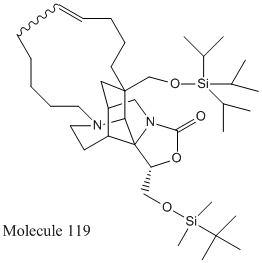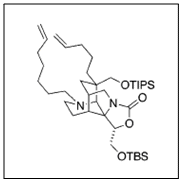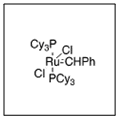 |
 |
Although Stewie Griffin is the youngest member of
his family, he is also the smartest. One of his
hobbies is to build different inventions. Organic
chemistry is important for the synthesis of many
molecules. Therefore, Stewie wants to understand
how to carry out as many reactions as possible. Here he tries to
understand how to synthesize Molecule 119.
A 5-L 3-neck round bottom flask was used. A reflux condenser and a straight tube adaptor with an in-line Teflon screw seal were attached to the flask. A septum was fitted to the straight tube adaptor and a gas flow adaptor was placed atop the reflux condenser. A gas dispersion tube was also attached. The flask was charged with methylene chloride (2.4 L) and diene 118 (416 mg, 0.59 mmol). Then the solution was sparged for 1 hour with a flow of argon through the gas dispersion tube. The solution was then heated to reflux and a solution of catalyst 121 (24.3 mg, 0.030 mmol) in methylene chloride (11 mL) was added in one portion through the septum, and the Teflon screw was firmly sealed to avoid contact of the solvent vapor with the rubber septum. The solution was under reflux for 8 hours under a flow of argon, and DMSO (400 µL) was added. The solution cooled to room temperature over 12 hours. Then the solvent was evaporated under reduced pressure. The residue was purified by flash chromatography on silica using a gradient solvent system (1:99 EtOAc:benzene; then 5:95 EtOAc:benzene) to provide macrocycles 119 as slightly yellow (2:1 mixture of E and Z isomers).
Reference:
Becker, M. H.; Chua, P.; Downham, R.; Douglas, C. J.; Garg, N. K.; Hiebert, S.; Jaroch, S.; Matsuoka, R. T.; Middleton, J. A.; Ng, F. W.; Overman, L. E. J. Am. Chem. Soc. 2007, 129, 11987 – 12002.
Molecule 118:

Sparge: To agitate the solution by introducing air or a compressed gas. In this case, the gas used is argon.
http://www.123explore.com/t/00014656968/ (accessed April 01, 2008)
Molecule 121: Grubbs’ First Generation Catalyst

Reflux: When a reaction has to be refluxed, the reagents are dissolved in a solvent, which is then kept at a constant temperature (near the boiling point of the solvent) by boiling the solvent, condensing it, and returning it to the flask.
Zubrick, J. W. The Organic Chem Lab Survival Manual: A Student’s Guide to Techniques, 7th Ed. Hoboken, NJ: John Wiley & Sons, Inc, 2008; p. 203.
Flash Chromatography: It is performed with the same setup as a column chromatography, except that it is under pressure.
Zubrick, J. W. The Organic Chem Lab Survival Manual: A Student’s Guide to Techniques, 7th Ed. Hoboken, NJ: John Wiley & Sons, Inc, 2008; pp. 244-245.
Macrocycle: A molecule containing a large ring. The molecule being synthesized in this reaction is a 13-membered macrocycle.
